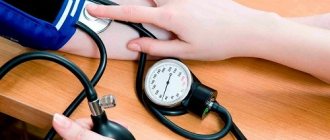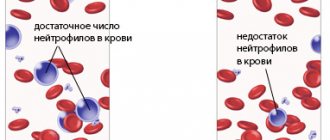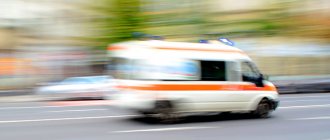Collapse as an indicator of pathological conditions in the body
Vascular collapse usually occurs as a result of a combination of exposure to various factors (pathogenic microorganisms, extremely low or high temperature, etc.) and the initial state of health. In other words, blood stops circulating normally, mainly in the presence of a serious pathology, a long-term chronic disease. The sudden development of collapse against the background of apparent complete well-being is a good reason to undergo a thorough further examination.
Changes in the body that occur during collapse
When the body is exposed to pathological factors, a pathogenetic chain of adverse events develops:
- decreased vascular tone leads to their expansion and an increase in the volume of the vascular bed;
- normal or reduced (due to blood loss, burns, dehydration, etc.) volume of circulating blood as a result of decreased vascular resistance cannot provide all organs and systems with adequate blood supply, and subsequently blood redistribution occurs;
- blood is redistributed unevenly: deposited in the vessels of the abdominal cavity and lungs, it enters the skin, muscle tissue, brain and kidneys in a significantly reduced mass;
- the return of blood to the heart is significantly reduced, so the heart begins to work at a faster pace to provide the body with blood flow;
- slowing down of blood flow in the vessels as a result of deposition and insufficiently efficient work of the heart lead to blood stagnation, the formation of blood clots and even greater circulatory disorders;
- inhibition of blood supply to individual organs leads to the formation of multiple organ failure (cardiovascular, cerebral, respiratory, renal) and the appearance of clinical manifestations of collapse.
FAONING CAUSED BY EMOTIONAL STRESS AND INTOXICATION
At first glance, it is difficult to explain why a person faints during severe emotional shocks or during illnesses such as influenza and pneumonia.
There is no dangerous loss of blood or fluid, which means there is no reason for a sharp decrease in blood pressure and cerebral ischemia.
To answer this question, let us remember: the volume of the vascular system of our body, including its capillary network, is many times greater than the volume of blood circulating in it. All our blood is not enough to fill even a third of the available vessels.
And yet we do not feel its shortage. Moreover, it seems that it is precisely the excess of rushing blood that pushes many hotheads to search for adventure.
The secret of this paradox is extremely simple and lies in the super-rational distribution of blood. It turns out that only those organs and muscles that are in a state of active work are primarily supplied with blood. It is their capillaries that are full of blood.
The remaining organs, which are at rest, are kept on a starvation diet: they are practically removed from the blood circulation and receive a minimum amount of blood to maintain their own vital functions.
Various groups of muscles or organs are periodically either in a state of rest or performing some kind of work. And also periodically the blood is redistributed between resting and working organs and muscles.
Using the well-known principle: “those who don’t work, don’t eat,” our body gets by just fine with only 4-6 liters of blood.
| THE MAIN CAUSE OF MOST FAINTING IS A DISRUPTION OF THE BLOOD DISTRIBUTION SYSTEM IN THE BODY. |
MECHANISM OF REGULATION OF PRE-CAPILLARY TONE
This universal distribution of blood is achieved by regulating the tone of the precapillaries. Located at the entrance to the capillary, they play the role of a squeezing cuff, the contraction of which can completely stop the flow of blood.
As soon as a certain amount of under-oxidized products, primarily lactic acid, accumulates in the tissues of non-functioning organs, and its level exceeds a certain limit, the tone of the precapillaries immediately decreases. Then a portion of fresh oxygen-rich blood enters the capillary network of the organ.
Excessive amounts of lactic acid quickly accumulate in the tissues of the working organ, and the tone of the precapillaries is constantly reduced. Their lumen is completely open. This allows for abundant blood supply throughout the entire period of active work.
The level of lactic acid is the regulator of precapillary tone, which so rationally distributes our blood in a colossal capillary network.
The state of precapillary tone, called PERIPHERAL RESISTANCE (PR), is also influenced by other factors that can either increase it or sharply decrease it.
With the release of large amounts of ADRENALINE and catecholamines, the tone of the precapillaries of organs such as the kidneys and liver, intestines and skin increases significantly. Their capillary network is almost completely excluded from the blood circulation.
BLOOD DISTRIBUTION WITH INCREASED PRE-CAPILLARY TONE (PS):
|
At the same time, the brain, heart and lungs receive much more blood. In the central blood vessels, blood pressure levels increase significantly. This phenomenon is called CENTRALIZATION OF BLOOD CIRCULATION.
A completely different picture emerges with a sharp decrease in precapillary tone (PC). In this case, a well-known everyday law comes into play: if a little something is divided among everyone, then no one will get anything.
In our case, this will turn into a tragedy. When the capillary system of the whole body is simultaneously filled, most of the blood from the central bloodstream is redistributed to the capillary network of the intestines, skin, spleen and muscles.
Especially a lot of blood accumulates in the muscles of the lower extremities (if the person is still standing). It will be removed from the blood circulation and will literally begin to be stored (DEPOSITED). In places of deposit (spleen, liver, intestines) there may be up to several liters of blood.
Thus, as soon as the principle of distribution is violated, the BCC will immediately decrease significantly, and the brain and other vital centers will be on the verge of disaster.
As a result, this is a familiar situation, but with the only difference that the deficiency of BCC was not caused by blood loss and dehydration, but by a sharp decrease in precapillary tone.
There are more than enough reasons why vascular tone decreases.
This is the state of the autonomic nervous system, subordinate to the cerebral cortex, and the activity of the subcortical centers for the regulation of vascular tone.
It is their negative effect on precapillary tone during fear or severe pain that often leads to fainting.
The presence of various toxins in the blood during poisoning and many infectious diseases has a particularly strong effect on the state of precapillary tone.
If emotional or painful fainting is quite fleeting, then during intoxication the threat of collapse and fainting persists for the entire duration of the presence of toxins.
BLOOD DISTRIBUTION WITH DECREASED PRE-CAPILLARY TONE (PS)
|
4
FAONING ASSOCIATED WITH HEART RHYTHM
Under the same circumstances of fainting, its depth and severity of complications vary from person to person. This depends on the psycho-emotional state, physical health and the presence of any concomitant diseases.
In one cute comedy, a young lady, seeing a mouse, falls with a languid “Ah!” into the hands of the hussar, and this leads to a happy ending. But there are so many cases in life when even happy but unexpected news ended in death from sudden cardiac arrest.
REMEMBER! The consequences of fainting are unpredictable.
The likelihood of death increases significantly with cardiac arrhythmias. In this case, death does not spare young people either.
During an attack, disruptions in the functioning of the heart lead to a short-term cardiac arrest. A state of clinical death sets in: the pulse in the carotid artery disappears, single convulsive twitching of the facial muscles appears, and after 5-6 seconds the pupils begin to dilate.
The outcome of the attack depends on how quickly the heart can return to normal function. If the pause lasted no more than 2-3 minutes, then it will be perceived as a normal fainting spell.
And if it’s at least 3-4 minutes longer, then...
In other words, each subsequent attack may result in death.
In many patients, such attacks manifest themselves in the form of short-term fainting. They can be so frequent and fleeting that the patient and his loved ones begin to get used to them, like minor annoying troubles.
REMEMBER! In case of sudden loss of consciousness, you should first make sure that there is a pulse in the carotid artery and, if there is none, begin resuscitation immediately
| IN ANY CASE OF SUDDEN LOSS OF CONSCIOUSNESS, IT IS NECESSARY TO CHECK FOR THE PRESENCE OF A PULSE IN THE CAROTID ARTERY. |
5
Reasons leading to the development of a collaptoid state
To date, the etiology of collapse has been well studied, which allows us to identify the main causes of its occurrence as a result of exposure to the body:
- infectious agents (causative agents of dysentery, botulism, meningoencephalitis, typhoid fever, influenza, and so on);
- massive blood loss (for example, as a result of injury, bleeding from a gastric or duodenal ulcer, from esophageal varices);
- severe burns;
- severe dehydration;
- toxins, poisons (especially cyanide, carbon monoxide, organophosphorus compounds);
- medications (most often antihypertensive, antiarrhythmic, b-blockers, as well as local anesthetics when released into the general bloodstream);
- various physical factors (too high or too low temperature, electric current, radioactive radiation):
- allergens (in case of development of an anaphylactic reaction);
- a decrease in venous tone, which leads to the development of orthostatic collapse (occurs after prolonged bed rest, a long-term serious illness, certain diseases of the endocrine system, and sometimes occurs in the postoperative period).
Almost everyone has encountered a condition (if not personally, then seen something similar in a film or read in literature) when a person who stood up quickly suddenly falls, “settles,” and becomes weaker. This is the so-called orthostatic collapse, which develops as a result of redistribution of blood flow, an increase in the vascular venous bed (due to decreased tone of the vein walls) and a significant decrease in the return of blood back to the heart.
Photo: https://pixabay.com/photos/medications-money-cure-tablets-257336/
In addition to the listed pathological factors, various acute diseases or chronic diseases in the deteriorating stage play an important role:
- cardiovascular - acute myocardial infarction, pulmonary embolism, severe heart rhythm disturbances (including pacemaker dysfunction), dissecting aortic aneurysm, artificial heart valve dysfunction, acute myocarditis, pericarditis and others;
- severe pneumonia;
- acute pancreatitis and so on.
Classification and features of the course of an emergency condition
The manifestations of collapse are divided according to several criteria. Doctors most often use the classification of emergency conditions according to the etiological factor. Let us consider the types and features of manifestations of collapse according to this division.
- Infectious-toxic type. It is a consequence of infectious diseases caused by bacteria.
- Toxic look. The appearance of collapse is associated with the effects of toxic substances on the human body. Most often, such lesions occur in connection with the professional activities of the victim.
- Hypoxemic appearance. Meteorologically sensitive people are susceptible to such collapse during times of high atmospheric pressure or a small amount of oxygen in the air in the room.
- Pancreatic view. Occurs due to injury or pathological changes in the pancreas.
- Burn appearance. Caused by deep lesions of the skin as a result of thermal burns.
- Hyperthermic appearance. Triggered by sunstroke or prolonged exposure to high temperatures.
- Dehydration appearance. Caused by extreme dehydration of the body.
- Hemorrhagic collapse. Occurs against the background of massive internal or external bleeding.
- Cardiac (cardiogenic) collapse. A dangerous condition is provoked by cardiac pathologies.
- Orthostatic collapse. It occurs due to a sudden change in body position in bedridden patients. However, manifestations of pathology can also occur in healthy people, especially in adolescence and childhood.
- Plasmoragic type. The origin of the collapse is due to severe diarrhea.
A separate group includes the enterogenic type, or, as it is also called, fainting, which occurs in patients with gastrectomy after a heavy meal.
Classification
Conventionally, the following types of collapse can be distinguished:
- cardiogenic - develops as a result of a decrease in cardiac output (blood volume from the ventricles of the heart), which is observed, for example, with extensive myocardial infarction, heart rhythm disturbances;
- vasodilation – formed with a sharp decrease in vascular tone (vascular resistance), most often as a result of overheating of the body, an overdose of certain medications, or the course of severe infectious processes;
- hypovolemic – occurs when the volume of circulating blood decreases as a result of massive bleeding, repeated vomiting and diarrhea, deep and extensive burns;
- orthostatic.
Collapse
Definition
Collapse is one of the forms of acute vascular insufficiency, characterized by a sharp drop in vascular tone or a rapid decrease in the mass of circulating blood, which leads to a decrease in venous flow to the heart, a drop in arterial and venous pressure, brain hypoxia and depression of vital functions of the body.
Etiology and pathogenesis
- acute infections (typhoid and typhus, meningoencephalitis, pneumonia, etc.),
- acute blood loss,
- diseases of the endocrine and nervous system (tumors, syringomyelia, etc.),
- exogenous intoxications (poisoning with carbon monoxide, organophosphorus compounds, etc.), + spinal and epidural anesthesia,
- orthostatic redistribution of blood (overdose of certain medications - ganglion blockers, insulin, antihypertensive drugs, etc.),
- acute diseases of the abdominal organs (peritonitis, etc.).
Collapse can be a complication of an acute violation of the contractile function of the myocardium, united by the concept of “small cardiac output syndrome,” which occurs in the acute period of myocardial infarction, with pronounced tachycardia, with deep bradycardia, with dysfunction of the sinus node, etc.
Clinical picture
For the most part, feelings of general weakness, dizziness suddenly develop, the patient complains of chilliness, chills, thirst; body temperature is reduced. The facial features are pointed, the limbs are cold, the skin and mucous membranes are pale with a cyanotic tint, the forehead, temples, sometimes the whole body is covered in cold sweat, a small and weak pulse, usually rapid, blood pressure is low, breathing is shallow, rapid, but despite shortness of breath, the patient does not experience suffocation and lies with his head low. Diuresis is reduced. Consciousness is preserved or obscured, the patient is indifferent to his surroundings, tremor of the fingers and sometimes convulsions are observed.
Treatment
Treatment is urgent. Depending on the cause - stopping bleeding, removing toxic substances from the body, using specific antidotes, eliminating hypoxia, etc. The patient is warmed up and placed with his legs elevated. Transfusion of blood substitutes is carried out and only according to strict indications - blood components. For low cardiac output syndrome, antiarrhythmic drugs are used (if it is caused by arrhythmia), cardiac pacing, etc.
Forecast
The prognosis is determined by the cause of collapse and the degree of vascular disorders.
Make an appointment
Symptoms of collapse
Collapse develops mainly suddenly and is characterized by the occurrence of typical clinical manifestations that accompany a sharp deterioration in a person’s condition. Among them, the most commonly observed are:
- severe general weakness;
- apathy, indifference to what is happening around, lethargy;
- dizziness, flashing “spots”, the appearance of a “veil” before the eyes;
- sweating, chills;
- thirst;
- significant reduction or cessation of urine output;
- rapid breathing and heartbeat, sometimes – interruptions in heart function;
- trembling of fingers, convulsions may occur.
During collapse, a sudden loss of consciousness may occur - fainting (syncope), which usually indicates suppression of blood supply to the brain.
Photo: https://pixabay.com/photos/forest-trees-sky-nature-green-1366345/
There are signs that can be used to predict an unfavorable outcome of collapse in the absence of timely assistance:
- severe headache that occurs suddenly;
- a burning sensation, heaviness behind the sternum, often spreading to the neck and lower jaw on the left, less often to the left arm;
- sharp “dagger” pain in the abdomen;
- a pronounced increase in breathing, while the person experiences suffocation;
- increased heart rate over 160 or decreased to less than 40 beats per minute;
- maintaining a significant decrease in blood pressure even after placing the patient in a horizontal position;
- the presence of known serious diseases in the victim (for example, life-threatening cardiac arrhythmias, aneurysm of the aorta or cerebral artery, chronic ischemic and non-ischemic diseases of the cardiovascular system, peptic ulcer, and so on);
- elderly age.
First aid for collapse: a reminder for those nearby
Act quickly and confidently, without wasting time in panic; your help can save the life of the victim.
First aid for collapse includes several simple but very important points.
- It is necessary to place the person on a hard horizontal surface, while raising the lower limbs (so that the legs and the surface are about 45 degrees).
- Try to stop bleeding if it exists, as well as stop exposure to other unfavorable factors, such as high fever.
- Open the windows to provide fresh air into the room.
- Unfasten belts, buttons, fasteners while keeping clothes tightly attached to the chest and stomach.
- Let the vapor of ammonia soaked in cotton wool or gauze be inhaled through your nose (hold it near your nose for no more than a second).
- If you have a chill, cover with a warm blanket or blanket (this especially applies to the lower extremities).
- Check the patency of the upper respiratory tract: examine the oral cavity for the presence of dentures, foreign objects, food (in order to avoid suffocation due to their entry into the larynx, trachea and bronchi).
- If a person is unconscious or vomiting, experts advise turning the victim on his side, securing this position with a roll of clothing or a blanket.
- If you have a tonometer, measure your blood pressure and count your pulse per minute.
- Call an ambulance, telling in detail about the person’s condition, describing the circumstances of the development of collapse (sudden deterioration in condition, symptoms that preceded it, previously taken medications, the presence of any diseases or pathological conditions, if known).
The appearance of the patient during collapse is of great importance (when seeking medical help, he should be presented in detail to the ambulance dispatcher): pallor of the skin, sometimes with bluish lips and fingers and toes, while the skin is cold, wet and sticky to the touch, dilation of the pupils is often observed, blood pressure is reduced or not determined, the pulse is often accelerated or very rare, weak (thread-like), and frequent shallow breathing is observed.
- Prepare medications taken by the patient, as well as the patient’s epicrisis from the outpatient card/medical history, electrocardiogram, prescriptions, and so on (this way, medical workers will have a better understanding of the patient’s medical history, which will allow them to quickly determine the cause of the collapse).
- Stay with the injured person until the ambulance arrives.
You should not administer any medications or perform medical procedures on your own without the necessary education! However, this statement does not apply to a situation where there is no breathing or heartbeat: any person must have the skills of cardiopulmonary resuscitation and provide it if necessary.
Photo: https://pixabay.com/photos/ambulance-medicine-hospital-1005433/
Specifics of urgent actions
Before providing first aid for fainting and collapse, you must urgently call an ambulance, explaining in detail the condition of the victim.
Then pre-medical measures are carried out according to the following algorithm of actions:
- The patient is placed on a hard, flat surface on his back;
- You need to raise his legs by placing rolled-up clothes or a blanket under them;
- When bringing a person to consciousness, turn his head to the side;
- Provide the victim with the opportunity to breathe freely by unbuttoning or removing all oppressive clothing;
- If the attack occurred indoors, open all the windows so that there is free circulation of fresh air in the room;
- Place warm heating pads on the patient’s arms and legs;
- For head injuries or when a person is unconscious, bring a cotton swab soaked in ammonia to his nose;
- In the absence of medication, use the technique of rubbing the temples or earlobes.
If collapse is caused by injury and blood loss, emergency care begins with stopping the bleeding. After the victim has regained consciousness, and the doctors have not yet arrived, provide him with complete emotional and physical rest.
When first aid is provided for fainting and collapse, the following actions are prohibited:
- Offer the patient any medications;
- In an unconscious state, he is forbidden to pour water into his mouth;
- To bring a person to his senses by slapping his cheeks or shaking him.
Note!
Collapse caused by internal bleeding is stopped with tourniquets and twists! Simply apply an ice pack to the injured area.
Medical assistance
First aid is provided by ambulance doctors. Their task is to restore natural blood circulation in the body. For these purposes, perform the following actions:
- Administration of intravenous sodium chloride or Ringer's solution;
- Use of glucocorticoids and antispasmodics;
- Intravenous administration of vasopressors.
The dosage and selection of drugs is carried out taking into account the following indicators:
- Color of the skin;
- Arterial pressure;
- Number and frequency of heartbeat;
- Presence or absence of diuresis.
After hospitalization, complex therapy is carried out, which is designed to affect the body in 4 directions.
- Eliminate factors that threaten the life of the victim;
- Block the causes that caused the state of collapse;
- Restore lost body functions;
- Prevent possible respiratory failure with oxygen therapy.
Despite the wide variety of types of pathological conditions that cause collapse, they are all extremely dangerous to human life and require immediate medical attention.
Diagnosis of the causes of collapse
In order to choose the right tactics for eliminating the collaptoid state, it is necessary to find out the cause of the development of the pathological condition.
For this we use:
- a thorough examination of the patient (presence of injuries, burns, active bleeding, condition of the skin, measurement of blood pressure, counting pulse and respiratory rate, assessment of heart rhythm, and so on);
- during a general examination, complaints are clarified, as well as an anamnesis of life and illness, the circumstances under which the condition worsened;
- general blood test (signs of bleeding, dehydration, infectious process, etc.);
- biochemical blood test (sugar level, kidney, liver, etc.);
- coagulogram (signs of activation or inhibition of the blood coagulation system);
- registration of an electrocardiogram (pay attention to the presence of blockades, serious heart rhythm disturbances, ischemic changes, as well as specific changes characteristic of other pathological conditions, for example, pulmonary embolism);
- according to indications, it is possible to conduct a more in-depth study: ECHO-CG, HM-ECG, EEG, FGDS, FCS, CT, MRI, X-ray and so on.
Doctors of various specialties are often invited to consultations, for example, a neurologist, cardiologist, arrhythmologist and others, if necessary.
Therapeutic measures
The reason for the development of collapse is determined by the algorithm for providing assistance:
- when exposed to poisons, toxins, drugs - remove substances from the body as quickly and completely as possible, use specific antidotes;
- stopping bleeding, replenishing blood loss with blood components or blood substitutes;
- stopping the use of the drug that caused anaphylactic shock, anti-shock measures (infusion therapy, antihistamines, adrenergic agonists, glucocorticosteroids, etc.);
- the use of antiarrhythmic drugs, electrical pulse therapy, temporary or implantable pacemakers for cardiac arrhythmias;
- the use of cardiotropic treatment for acute myocardial infarction, myocarditis, pericarditis, cardiomyopathies and other diseases of the cardiovascular system;
- the use of antiviral and/or antibacterial drugs in the presence of an infectious process, and so on (depending on the etiological factor).
Photo: https://pixabay.com/photos/medicine-pills-blood-pressure-2994788/
Emergency care for collapse of almost any etiology includes the use of:
- inhalation of humidified oxygen;
- infusion therapy;
- glucocorticosteroids;
- vasopressor drugs.
These measures are used after performing the first aid described above. The patient is usually hospitalized in the intensive care unit (or in a specialized hospital), where treatment and monitoring of hemodynamic parameters continue.
Types of collapse
Depending on its pathogenesis, collapse occurs:
- traumatic – provoked by severe injuries;
- hemorrhagic - appears after significant blood loss;
- burn - begins after receiving third or fourth degree burns;
- anaphylactic – caused by a severe allergic reaction;
- infectious – occurs at the peak of development of an infectious disease;
- hemolytic – caused by incompatibility of blood during transfusion;
- orthostatic - is the result of a sharp bringing of the body into a vertical position;
- hypovolemic – characterized by a decrease in blood volume in the vessels;
- cardiogenic – occurs due to damage to the heart muscle;
- vascular – associated with a decrease in the elasticity and strength of blood vessels;
- mixed – combines several reasons.
Symptoms of collapse
It is not possible to confuse collapse with another disease, since its signs are usually very clear:
- paleness or cyanosis;
- sallow complexion;
- sharp facial features;
- weakness, up to loss of consciousness;
- severe headache and dizziness;
- pronounced rapid heartbeat;
- noise in ears;
- feeling of cold and fear;
- decrease in temperature and pressure;
- the appearance of sticky sweat;
- blurred vision;
- pupil dilation.
The danger of a collapsed state
When collapse develops, it is important to remember that the further prognosis depends on how quickly the correct emergency care is provided. You need to understand that minutes of delay can cost the victim his life. In the absence of adequate medical care, collapse quickly leads to multiple organ failure and disruption of the normal functioning of internal organs.
The greatest danger is the developing disruption of the blood supply to the brain, which can lead to ischemia and massive death of nerve cells.








